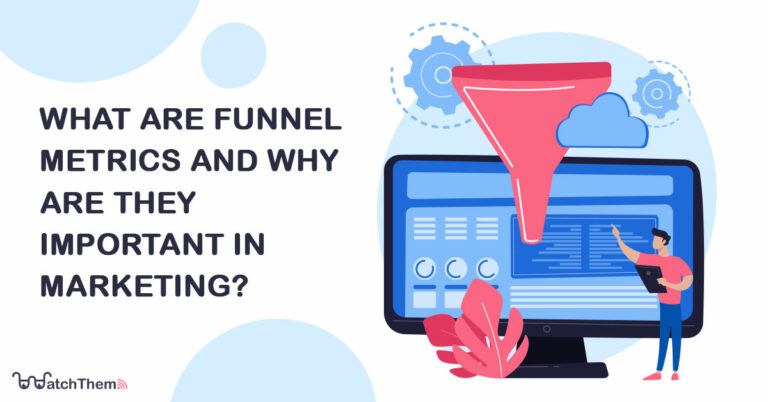Page Contents
Tracking sales funnel metrics is essential as it enables you to identify the leaks in your funnel. Therefore, you’ll be able to optimize your sales funnel more effectively and improve your marketing strategies to boost conversions. First, however, you need to know which marketing funnel metrics to focus on for the best results.
This blog post will discuss the most important conversion funnel metrics you should monitor to increase revenue. So, read on and find out all you need to know about these metrics.
Note: WatchThemLive is a tool that helps web companies reduce funnel abandonment by identifying which pages and flows are most challenging for their users. By recording a live session of how people use the site, you can easily see how people drop off at each step in your process. SIGN UP right now and grab your FREE package!
What Are Funnel Metrics?
Sales funnel metrics are a set of metrics that help businesses measure the effectiveness of their sales funnels. Moreover, these metrics enable companies to find and fix the issues in their marketing funnel. Therefore, tracking funnel metrics is an excellent way to figure out how to expand your customer base.
Why Is Tracking Funnel Metrics Important?
Now, let’s take a look at some of the benefits of tracking growth funnel metrics:
1- Identifying the Real Problem
Tracking marketing funnel metrics helps you identify where the problem exactly is. For example, if your website’s conversion rate is low, you will know what areas really need improvement.
By analyzing your metrics, you can eliminate the guesswork in your marketing, which is usually a waste of time and resources.
For example, with the help of funnel metrics, you might discover a considerable percentage of your customers abandon the checkout process. So, you need to find out what’s stopping them from completing their purchase and how to optimize the checkout process. For example, maybe the additional charges are too high, or the process is too long and complicated.
2- Improving Your Marketing Strategy
By tracking conversion funnel metrics, you will gain data-driven insights that help you make better marketing decisions. In addition, the insights allow you to improve your marketing strategy based on your target market’s needs and behavior.
You can read more articles about marketing strategy here.
3- Aligning Sales and Marketing
Aligning your sales and marketing is necessary for business growth. The success of your business strongly depends on how sales and marketing work together.
Keeping an eye on these metrics lets you understand how your marketing strategies effectively move leads through the sales funnel. Then, you will develop more successful and cost-effective strategies.


What Are the Most Important Funnel Metrics?
Let’s see what the most important eCommerce funnel metrics are and how to calculate them:
1- Number of Entrances
The number of entrances is one of the top-of-funnel metrics that shows the total number of contacts that enter your marketing funnel in a specific time frame. To calculate this metric, you first need to identify the starting point of your funnel. Is it when someone visits your website? Does it begin when they subscribe to your email list or click on your ad?
After defining your funnel’s entry points, you can easily find the number of entrances for each marketing channel.
Usually, this metric refers to a website’s traffic at a specific time. However, you should also track your return traffic as most visitors don’t move to the next funnel stage on the first visit.
2- Leads
Not anyone who visits your website is a lead. Visitors turn into leads only when they start showing interest in your offer. There are two types of leads you should consider when measuring the number of generated leads: marketing qualified leads (MQL), and sales qualified leads (SQL).
The number of MQLs you generate indicates the effectiveness of the middle stages of your funnel. These leads are people who are likely to become paying customers.
On the other hand, SQLs are ready to make a purchase. Therefore, the more MQLs you convert into SQLs, the more successful your lead nurturing strategy has been.
3- Conversion Rate
Conversion rate is a marketing funnel metric that indicates the percentage of leads that become customers. Tracking this metric is crucial as the goal is to convert the most number of leads. Thus, monitoring the conversion rate can help you increase your revenue.
Remember to define what a conversion means to your business. A conversion doesn’t always refer to a sale. It can be other desired actions such as account sign-ups, ebook downloads, email subscriptions, etc. You can also have multiple conversion goals throughout your funnel, which you need to track.
Now let’s find out how to calculate the conversion rate. This metric is calculated by dividing the number of conversions by the number of funnel entrances and multiplying it by 100.
If you are tracking multiple goals, you can calculate the conversion rate separately. For each funnel stage, divide the number of contacts who pass through that stage by the number of contacts who enter it and multiply it by 100.
An excellent way to increase your conversion rate is by using a website visitor tracking tool such as WatchThemLive. This tool offers features like heatmaps and session replays that help you better understand your website visitors. These features allow you to identify what’s preventing visitors from converting. You can also find user experience problems and drop-off points on your website.
Try out WatchThemLive now and boost conversions! There’s a free plan ready for you, so SIGN UP right now!
4- Costs
Your marketing efforts should be focused on increasing revenue. However, you must keep an eye on your costs to ensure your business’s financial health.
There are several metrics you should track to understand your costs:
- Cost per lead (CPL)
- Cost per sale (CPS)
- Customer acquisition cost (CAC)
Cost per lead is how much you spend to generate a single lead. To calculate this metric, divide your total marketing costs by the number of leads generated.
Cost per sale is the amount you pay for each sale generated by a specific advertisement. To find your CPS, divide the total amount you spent on the ad by sales revenue.
Customer acquisition cost is the total amount of money you spend to acquire a new customer. To calculate your CAC, divide all the costs spent on acquiring new customers by the number of customers you’ve gained.
5- Revenue
The next thing you must track is your revenue and ROI by lead sources. This helps you figure out which channels bring in the most revenue for your business. Therefore, you will know where to focus your marketing efforts. You should track each lead source (email marketing, organic search, social media, etc.) with a different conversion funnel.
These are the funnel metrics you need to track that are related to revenue:
- Average order value (AOV)
- Customer lifetime value (CLV)
- Sales velocity
Average order value is a metric that shows you the amount of money customers spend per order. Calculate your AOV by dividing your total generated revenue by the number of orders.
This metric can tell you the value of each customer who reaches the bottom of the eCommerce funnel. You can increase your AOV by using strategies like product bundling, upselling, and cross-selling.
Customer lifetime value refers to the total revenue you earn from a single customer throughout their relationship with your business. Follow these steps to calculate your CLV:
1- Calculate the average purchase value (APV = total revenue/number of orders)
2- Calculate the average purchase frequency rate (APFR = number of purchases/number of customers)
3- Calculate the customer value (CV = average purchase value x average purchase frequency rate)
4- Calculate the average customer lifespan (sum of customer lifespans/number of customers)
5- Now, you can calculate your CLV by multiplying the customer value by the average customer lifespan.
Sales velocity determines how quickly you generate revenue and contacts move through the funnel. To calculate your sales velocity, multiply the number of sales opportunities by the average deal value and win rate, then divide it by the length of the sales cycle.
This metric helps you understand how to reach your business goals and how much revenue you can expect to generate.
6- Duration of the Sales Process
The duration of the sales process indicates the average time it takes for a contact to become a customer. A shorter period means that your conversion funnel is more successful.
Calculate this funnel metric by subtracting the time when a contact enters the funnel from when they make a purchase.
It would also be a great idea to calculate the duration for each funnel stage. This way, you can identify the more practical stages and the poor-performing ones.
7- Funnel Drop-Offs
Funnel drop-off or abandonment rate is defined as the percentage of visitors that leave a funnel (conversion process) without finalizing their conversion. As much as you want to increase your conversion rate as an online retailer, you want to keep the number of your funnel drop-offs as low as possible.
Using the abandonment rate you will be able to realize which stages in your funnel are leading consumers to leave the conversion process. Analyzing those stages will enable you to take the appropriate actions to reduce drop-offs and increase conversions.
You can use both of these formulae to calculate your funnel drop-off rate:
Subtract the number of visits of the first conversion step from the number of visits of the current conversion step, then divide the number by, again, the number of visits of the first conversion step. To find the percentage you can multiply the answer by 100.


You can also calculate your drop-off rate by subtracting the number of visits of the previous conversion step from the number of visits of the current conversion step, then dividing the number by the number of visits of the previous conversion step. To find the percentage, multiply the answer by 100.


You should have in mind that the funnel drop-off rate is not going to help you make the proper change by itself. In order to solve the problem that’s causing the visitors to leave, you need to use a session recording tool such as WatchThemLive. This way you can see the journey your users go through and identify the reason for their abandonment. You only need to embed the tracking code in your website and you will have access to user session recordings.
Make sure to SIGN UP and start tracking your users’ behavior on your website FOR FREE FOREVER.
Conclusion
Tracking conversion funnel metrics helps you identify the gaps in your funnel. Therefore, you will know what you need to do to increase your conversions. Make sure to track the right metrics to identify opportunities for improvement.
In this article, we started off by explaining what funnel metrics are and discussed their importance. Then, we introduced 7 of the most essential funnel metrics that you will need to calculate and analyze to achieve insightful information about your business and find ways to improve it.


